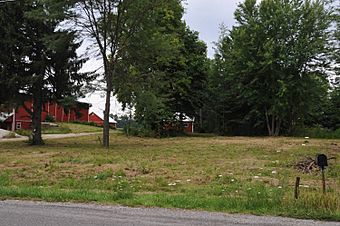Paleo Crossing site facts for kids
Quick facts for kids |
|
|
Paleo Crossing site
|
|
 |
|
| Location | Northwest of the junction of Ridgewood and State Roads, Sharon Township, Medina County, Ohio (private) |
|---|---|
| Nearest city | Sharon Center, Ohio |
| NRHP reference No. | 92000972 |
| Added to NRHP | July 30, 1992 |
The Paleo Crossing site, also known as the Old Dague Farm site, is an important archaeological site near Sharon Center, Ohio. It is located in Medina County. Here, scientists found special tools and artifacts from the Clovis culture. These items are about 10,980 years old.
The Cleveland Museum of Natural History dug at this site from 1990 to 1993. The Paleo Crossing site helps us learn about the Paleo-Indians who lived in northern Ohio. These early people might be "some of the oldest certain examples of human activity in the New World." This is what archaeologist Dr. David Brose believes.
At the site, researchers found charcoal in old trash pits. They also found two post holes, which are spots where wooden posts once stood. Many tools and blades were also discovered. About 80% of these tools were made from a type of flint called Wyandotte chert. This flint came from the Ohio River Valley in Indiana, which is about 500 miles away. This shows that these ancient hunter-gatherers had connections with people far away. It also suggests they could travel long distances quite quickly. The post holes are exciting because they suggest a shelter was built at the site.
The Paleo Crossing site was added to the National Register of Historic Places on July 30, 1992. This means it is a very important historical place.
Contents
Discovering the Past
Spearheads were first found by a local collector in Sharon Center, Ohio. From 1990 to 1993, the Cleveland Museum of Natural History led an excavation here. Dr. David Brose, who was the Curator of Archaeology, studied the spearheads. He realized they were in the style of Clovis points. These points were made by Paleo-Indians. Dr. Brose called them "some of the oldest certain examples of human activity in the New World."
The Clovis Culture
The Clovis culture was a group of early people who spread across North America. Many scientists believe they were the ancestors of most native peoples in America. There are about 200 Clovis sites found across the continent. However, many of them do not offer much information about the Clovis way of life. The Paleo Crossing site is special because it tells us more.
What the Dig Found
The Paleo Crossing site is one of the oldest sites in Ohio. During the dig, archaeologists found two or three post holes and old trash pits. These pits contained charcoal. Using a method called radiocarbon dating, scientists estimated the site was used about 10,980 years ago. This is roughly 9,000 B.C. The post holes and an area about 150 square feet suggest there was a structure at the site. If this is true, it would be the oldest building ever found in North America. The structure, dated to about 10,200 B.C., might have burned down. This is suggested by the charcoal found in a post hole.
However, some scientists have recently questioned the dates from the site. They are unsure about where the charcoal samples came from. Because of this, they now say that all the earlier dates for Paleo Crossing should not be used. They now consider the site "undated."
More than 10,000 artifacts were found at the site. Most of the flint tools were made from stone found about 500 kilometers (310 miles) away. This stone came from a quarry in southern Indiana. Many of the tools and blades found were heavily reshaped. This probably happened because the original stone material had to be carried such a long distance.
Ancient Environment
When Paleo-Indians visited the Paleo Crossing site, the large sheets of glacial ice had likely melted away. The area was probably a "lush" environment with lots of plants. A bog, which is a type of wetland, was nearby. This bog would have attracted animals, like mastodons, to the water. The ancient structure was built above what was once this bog. It was also below a ridge. Today, that bog area is wet farmland.
Images for kids




